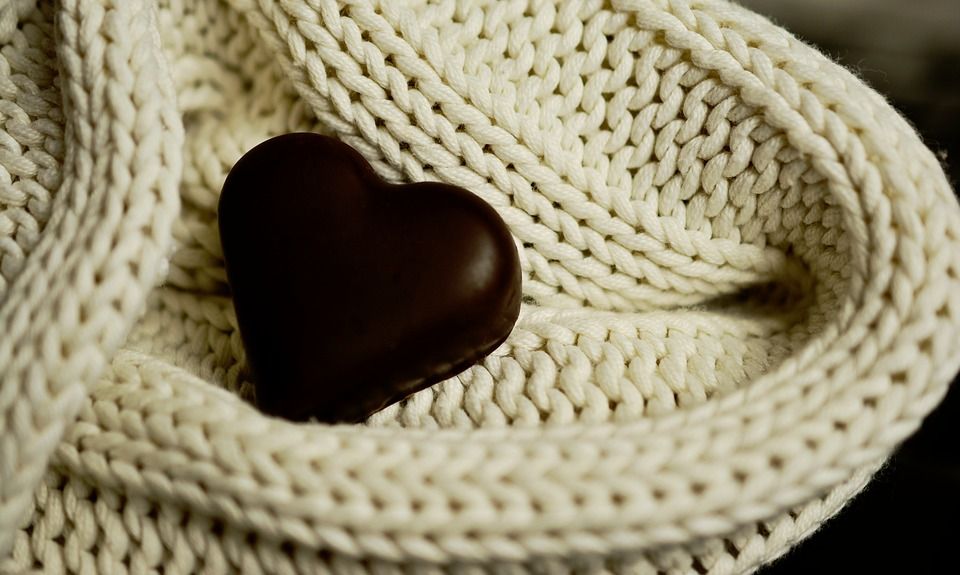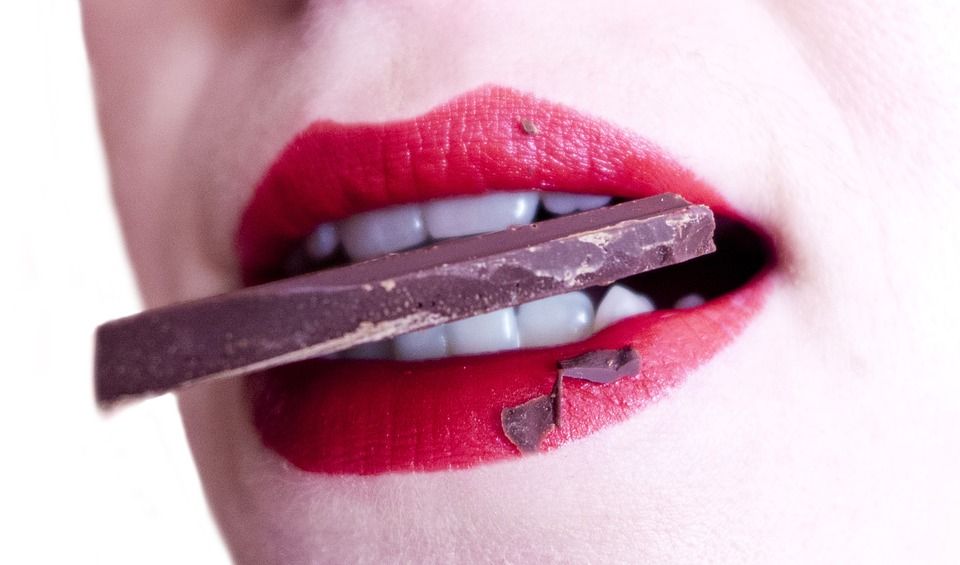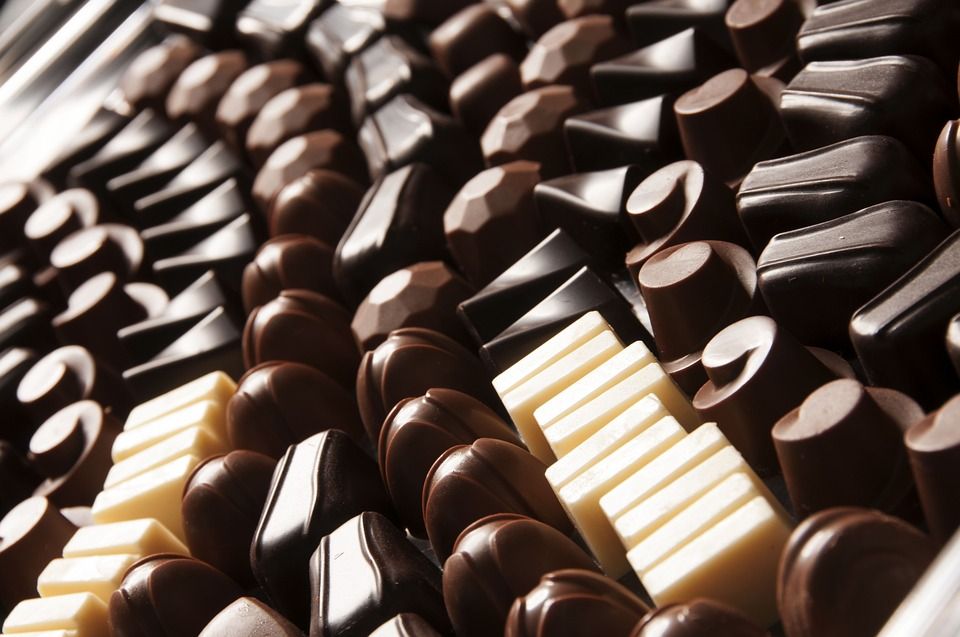When you are jonesing for chocolate, do you run for a milk chocolate Hershey bar or do prefer Dark Chocolate Dove pieces? Or do you love white chocolate or some other variation?
Most chocolate lovers have their preference for a major type of chocolate. The full list of types of chocolate includes not just white, dark, and milk chocolate, but also semi- sweet, bittersweet, or unsweetened in addition to cocoa. Chocolate is classified by types based on the proportion of cocoa, fat, and sugar used in particular formulations. Categories may vary throughout the world, depending on national regulation.
What Constitutes Popular Types Of Chocolate?
In the chocolate industry, chocolate is made with varying percentages of parts of the cocoa bean:
- Chocolate liquor, the ground or melted state of the nib of the cacao bean, comprised roughly equal parts cocoa butter and solids.
- Cocoa butter, the fatty component of the bean.
- Cocoa solids, the remaining nonfat part of the cocoa bean, are ground into a powder.
Each type of chocolate has different percentages of these components,
White chocolate is made with cocoa butter, sugar, milk, emulsifier, vanilla, and other flavors. The lack of nonfat ingredients from the cocoa bean contributes to its off-white color. With a mild, pleasant flavor, it is often used in desserts or in candy such as White Chocolate Drops or Hershey’s White Kisses.
Milk chocolate, a popular form of candy for bars, includes 10 to 20% cocoa solids including cocoa and cocoa butter, and more than 12% milk solids. Created in 1875 by Swiss confectioner Daniel Peter, the product uses condensed milk, invented by his neighbor Henri Nestle.
In the US, this most popular form of milk chocolate is made by Hershey. Its product has a particular taste due to the process of breaking down the milk and then stabilizing it through pasteurization.

Dark chocolate, with a high content of cocoa liquor, may contain 12% milk solids. Its forms may range from unsweetened when the percentage of cocoa liquor is closer to 100% to sweeter variations. Unsweetened chocolate is so bitter that it is only used for baking.
Sweet dark chocolate contains 35 to 45% cocoa solids and is similar in taste to semi-sweet chocolate that may include 40 to 62% cocoa solids. Often used for baking cakes, cookies, and brownies, it is good to eat. Popular for chocolate chips cookies, semi-sweet chocolate pieces are good right out of the bag. Ghiaridelli Squares, Sno Caps or Hershey’s Special Dark are popular variation of sweet dark chocolate candy.
Keeping Chocolate Pure
In an attempt to vary ingredients in chocolate, often by using more economical ones, the Chocolate Manufacturers Association lobbied the FDA in 2007 to change the legal definition of chocolate so they could substitute other fats and oils for cocoa butter, other sweeteners for sugar, and other substitutes for milk. The FDA held with the original definition so that in the U.S., products containing substitutes can only be referred to as “chocolatey” or labeled as “made with chocolate.”

The Popularity Of Chocolate
Chocolate is the most popular sweet treat in the world; chocolate lovers consume more than 3 million tons of cocoa beans a year, Demand is particularly high in the United States and Europe. It not only tastes good and lifts the mood, but when eaten in moderation (2-3 times per week) may reduce the chances of coronary heart disease, atrial fibrillation, stroke, and diabetes; one study on coronary artery disease suggested that eating an ounce of chocolate five times a week is optimum. Dark chocolate may have more benefit as it usually contains less sugar and less milk that dilutes the concentration of cacao, Because of the high sugar content, overconsumption is not recommended – but this can be challenging for a chocolate lover!
Whether you crave chocolate, well, because it’s chocolate, or you want the health benefits, Sweet Services, online bulk candy distributor, offers a wide range of chocolate treats.
Chocolate’s Historical and Cultural Context
People have enjoyed chocolate for thousands of years. Indigenous Americans like the Maya and Aztecs thought cacao was the food of the gods. They turned it into a bitter drink that was often spiced. However, it was only available to royals and warriors, as well as during religious ceremonies. Cacao beans were so valuable in pre-Columbian societies that they were even used as currency.
Spanish explorers were introduced to cacao in the 16th century, and they brought the beans back to Europe. At that point the product underwent quite the transformation. Sugar was added to the beverage, and it soon became a favorite for European aristocracy.
It wasn’t long before better processing and production methods helped lower the cost of chocolate, so it became widely available to the public. When the Industrial Revolution rolled around, new machinery began to produce chocolate on larger scales, which really revolutionized its availability to the masses.
Nowadays, chocolate is culturally significant all around the world. It plays its own role in holiday traditions like Valentine’s Day and Easter. Aside from that, it’s frequently associated with celebration, comfort, and indulgence. Indeed, chocolate can suit practically any occasion. It doesn’t matter if its’ a simple candy bar or a luxurious truffle, chocolate is a tradition that spans both centuries and continents.
Professional and Creative Applications
Chocolate is for so much more than a mere snack. It’s an entire industry. Professional chocolatiers and chefs use chocolate as a main ingredient in stunning desserts, intricate sculptures, and even savory, gourmet dishes.
Tempering chocolate is an artform – a learned technique where the cook heats and cools it to precise temperatures. Tempering gives the chocolate a shiny finish and a satisfying snap when you break off a piece. It’s a needed skill if you want to make high-quality chocolate confections that have a professional appearance.
Chocolate has become a versatile ingredient in the culinary world. It’s used in ganache, mousse, and fondue, where chocolate adds depth to each of the desserts. But it’s not limited to sweets. Chocolate also can be incorporated into savory dishes like mole sauce. Its natural bitterness balances spices to create complex flavors. Many chocolatiers also do their own experiments with chocolate by adding nuts, fruits, and spices for unique flavor combinations.
Chocolate creations aren’t limited to professionals. Home bakers and hobbyists embrace chocolate’s versatility just as much. Chocolate can be melted for drizzling over desserts, grated for garnishing dishes, or chopped into chunks for baking recipes.
Chocolate fountains have become a popular feature at parties around the world. They’re an interactive way to enjoy chocolate-covered fruits, marshmallows, and other treats while socializing. Thanks to molds and edible decorations, pretty much anyone can create personalized confections for special occasions – or just because.
Terroir and Flavor Profiles
Chocolate is much like wine and coffee in that its flavor can vary depending on where it was grown. Terroir – a region’s environmental conditions – can influence its taste. That means things like the soil composition, climate, and altitude where the beans are grown give each crop of cacao their own unique flavor characteristics. Beans from Ecuador, for example, might produce chocolate with floral or fruit notes. Those cultivated in Ghana, on the other hand, are more likely to yield bolder and earthier flavors.
Those unique flavor profiles are especially evident in single-origin chocolate. By sampling chocolate from different regions, you can start to identify subtle differences in things like acidity, sweetness, and bitterness. That desire for flavor exploration has led to more bean-to-bar chocolatiers. They prioritize quality and transparency in their chocolate-making processes.
Much as people love attending wine and coffee tastings, chocolate tasting is becoming a popular activity. Participants at these events learn to identify flavor notes so they can better appreciate chocolate craftsmanship.
It really doesn’t make any difference if you’re a casual chocolate lover who enjoys a classic Hershey bar or a true connoisseur looking for the latest gourmet combination. Terroir can add a whole new dimension to your chocolate appreciation.
Chocolate Processing Techniques
You can’t go from cacao bean to a chocolate bar without taking certain steps. Once the beans are harvested, they’re fermented and dried in order to develop their flavors. Fermentation lasts several days. The important process changes beans from a raw and bitter taste into something more complex. After that, drying helps make sure the beans are ready for the next stages.
Next comes roasting. It darkens the cacao beans and brings out their rich aromas. This step requires great precision on the part of the chocolatier since different times and temperatures can change the chocolate’s final flavor. After they’re roasted, beans are cracked and winnowed to separate the nibs from the shells.
Then the nibs are ground into a thick paste known as a chocolate liquor. This forms the base for all chocolate products. Chocolate liquor can be further processed into cocoa powder, butter, or solid chocolate. Another process, connching, happens when the chocolate is continuously mixed and aerated, which refines its texture and flavor.
Finally, tampering is the last step. It helps make sure the chocolate has a smooth finish. It also prevents blooming, something that occurs when fat or sugar crystals form on the product’s surface.
Every step in the chocolate-making process gives the sweet treat added depth and complexity so it meets the highest standards in terms of taste and texture. These processes are becoming even more refined thanks to advances in technology and techniques. Thus, chocolatiers are creating innovative and higher-quality products.
Chocolate’s Different Forms
You can pretty much find some form of chocolate to fit any preference or occasion. Everybody knows about chocolate bars and squares. They’re perfect for on-the-go enjoyment, a simple way to savor chocolate’s rich flavors. Then you have chips and chunks – ideal for baking, they add bursts of chocolatey goodness to cookies, muffins, and other treats.
Other chocolate is more of a speciality. Options like truffles, pralines, and bonbons offer a luxurious culinary experience. Bite-sized creations like these often feature creamy fillings, crunchy nuts, or fruity centers. That makes them great for gifting on special occasions. You can even get seasonal chocolates shaped like hearts, eggs, or Santas to add extra joy to holidays and celebrations.
Then you have bulk chocolate options. Maybe you’re looking for chocolate coins, candy-coated chocolates, or chocolate-covered nuts. These are great for parties, events, or even just stocking up your own pantry. Sweet Services features a wide selection of bulk chocolates, so you can find the right sweet for every moment.
Let’s not forget that chocolate also takes on the form of powdered cacao. You can use it for baking, as well as to make hot chocolate. It’s a versatile product that allows for all sorts of creativity in the kitchen – whether you’re making chocolate cakes or rich, velvety drinks.
It really doesn’t matter what its form, chocolate will always remain a practically-universally loved treat.
Health and Nutritional Aspects
Can chocolate be good for you? It all depends on how you consume it. Like so many aspects of life, moderation is key.
Dark chocolate is particularly healthy since it’s so rich in antioxidants. Termed flavonoids, these help reduce inflammation, and they protect against cell damage. Dark chocolate also contains magnesium, iron, and zinc – all nutrients that support overall health.
Some studies even suggest that consuming small amounts of chocolate can improve heart health. It does this with lowered blood pressure, reduced cholesterol levels, and better blood flow. Chocolate is also associated with better brain function. It can increase blood flow to the brain thanks to natural stimulants like caffeine and theobromine.
Milk chocolate has lower cacao content, so it’s not quite as beneficial as dark chocolate. Still, it’s a comforting treat that will satisfy your cravings. Milk chocolate still contains calcium and other nutrients derived from milk. That makes it an absolutely delicious way to indulge in moderation. White chocolate is less nutritious, but it still adds a creamy sweetness to desserts, where it pairs well with a variety of other flavors.
You can get the most from chocolate’s benefits by choosing sweets with minimal additives and a high cacao content. Go ahead and pair it with nuts, fruits, or even whole gains – you’ll give an added boost to the chocolate’s nutritional value.
If you’re craving something sweet, check out the inventory from Sweet Services. There’s a huge selection of bulk chocolate – something to satisfy all your needs. Whether you’re looking for classic favorites or speciality treats, you’re bound to find everything you need for chocolate indulgence. Take a look at our online store, and order your favorites today!



Leave a Reply
You must be logged in to post a comment.